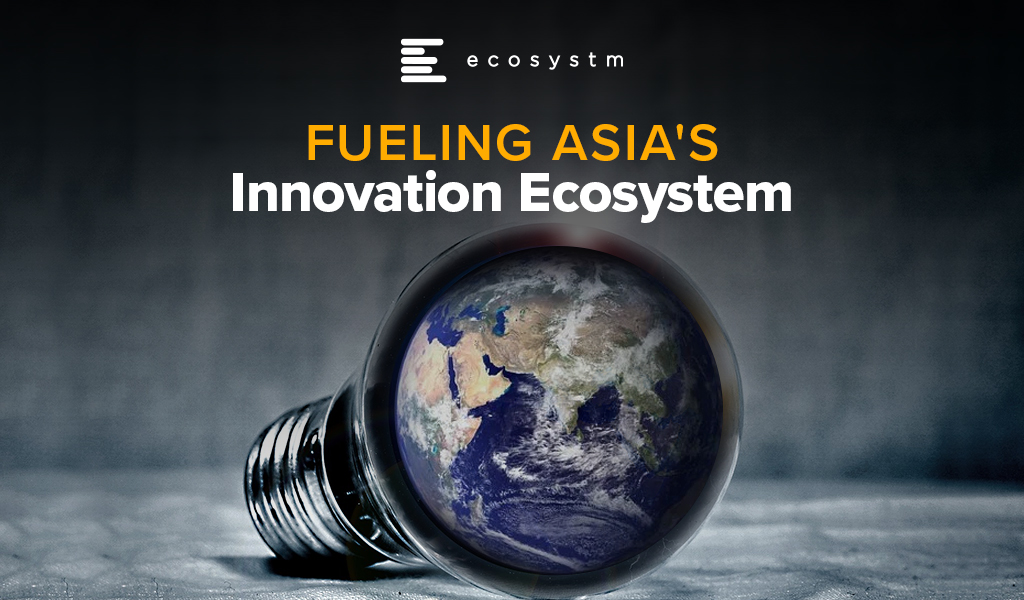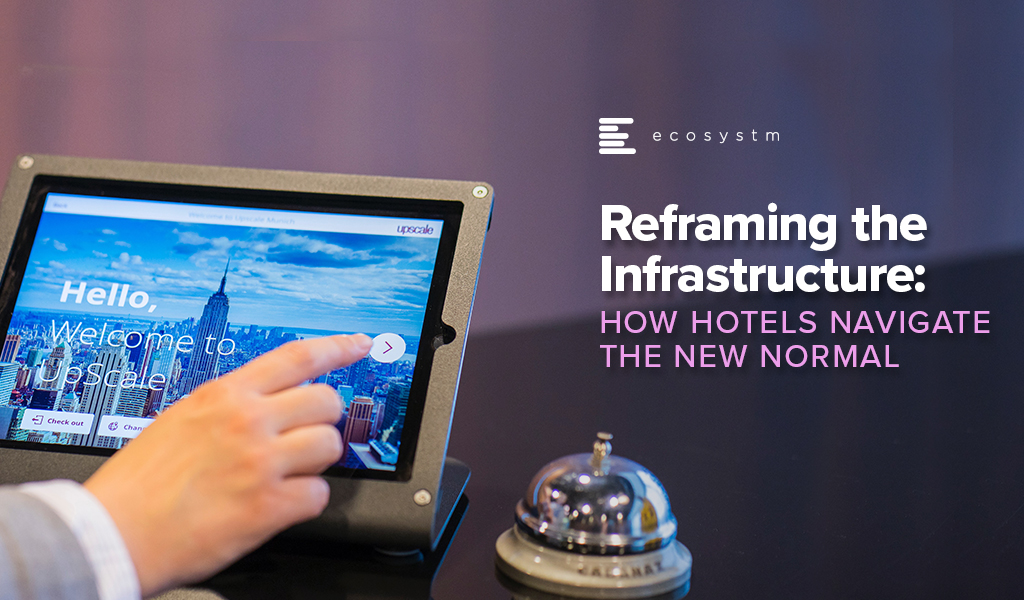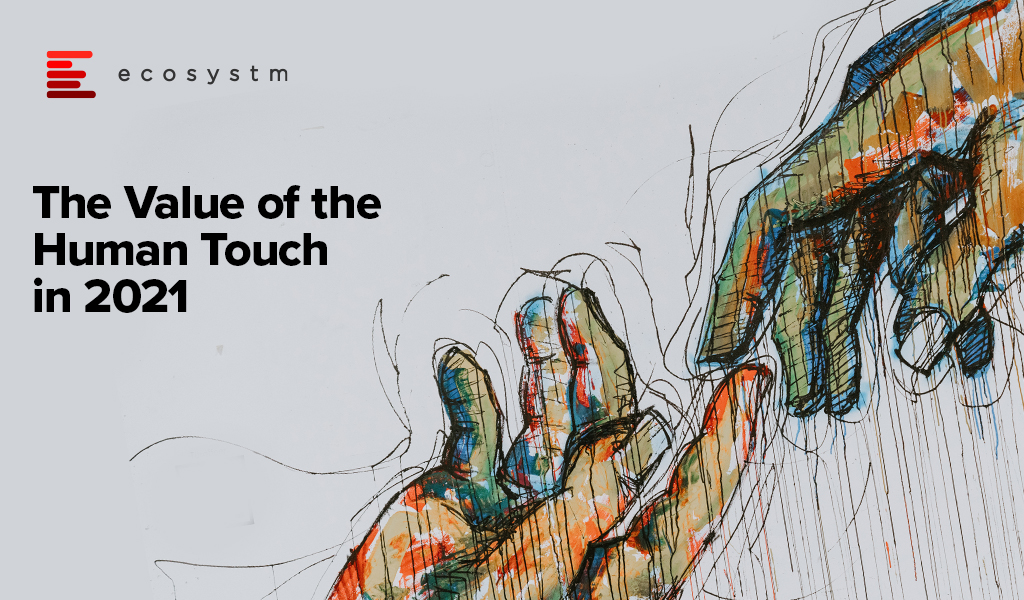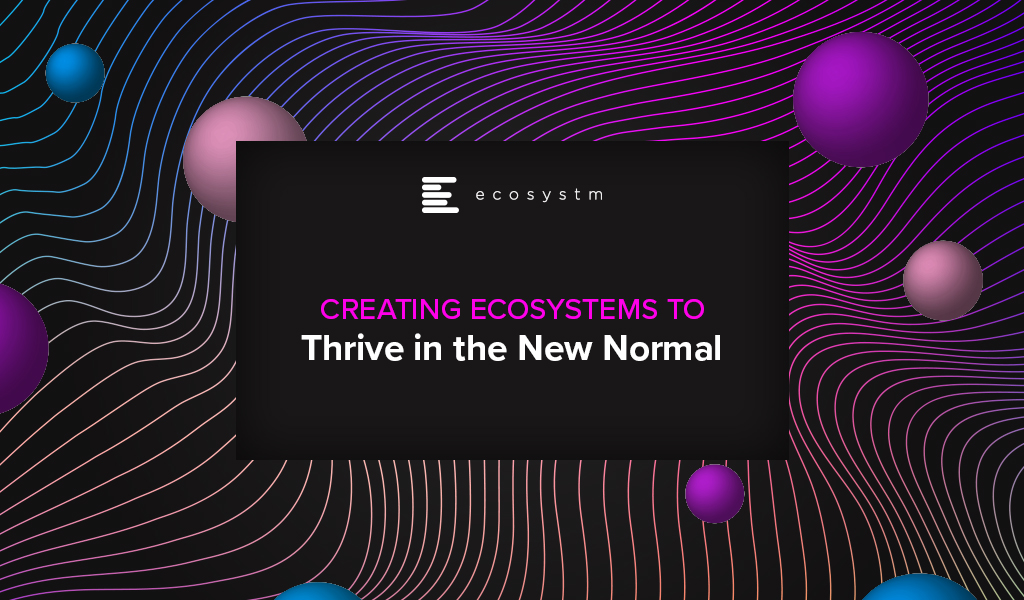Since the start of this millennium, no region has transformed as much as Asia. There has been significant paradigm shifts in the region and the perception that innovation starts in the US or in Europe and percolates through to Asia after a time lag, has been shattered. Asia is constantly demonstrating how dynamic, and technology-focused it is. This is getting fueled by the impact of the growing middle class on consumerism and the spirit of innovation across the region. The region has also seen a surge in new and upcoming business leaders who are embracing change and looking beyond success to creating impact.
What is Driving Innovation in Asia?
The “If you ain’t got it, build it” attitude. One of the key drivers of this shift is the age of the average population in Asia. According to the UN the Asia Pacific region has nearly 60% of the world’s youth population (between the age of 17-24). With youth comes dynamism, a desire to change the world, and innovation. As this age group enters the workforce, they will transform their lives and the companies they work in. They are already showing a spirit of agility when it comes to solving challenges – they will build what they do not have.
The Need to enable Foundational Shifts. The younger generation is more aware of environmental, social and governance issues that the world continues to face. Many of the countries in the region are emerging economies, where these issues become more apparent. COVID-19 has also inculcated an empathy in people and they are thinking of future success in terms of impact. The desire to enable foundational shifts is giving direction to the transformation journey in the region. The wonderful new paradigm that is the Digital Economy allows us to cut across all segments; and technology and its advancements has immense potential to create a more sustainable and inclusive future for the world.
Realising the Power of Momentum. The pandemic has caused major disruptions in the region. But every crisis also presents an opportunity to perhaps re-imagine a brighter world through a digital lens. The other thing that the pandemic has done is made people and organisations realise that to succeed they need to be open to change – and that momentum is important. As organisations had to pivot fast, they realised what I have been saying for years – we shouldn’t “let perfect get in the way of better”. This adaptability and the readiness to fail fast and learn from the mistakes early for eventual success, is leading to faster and more agile transformation journeys.
Where are we seeing the most impact?
Industries are Transforming. There are industries such as Healthcare and Education that had to transform out of a necessity and urgency brought about by the COVID-19 pandemic. This has led to a greater impetus for change and optimism in these industries. These industries will continue to transform as governments focus significantly on creating “Social Safety Nets” and technology plays a key role in enabling critical services across Health, Education and Food Security. Then there are industries, such as the Financial Services and Retail, that had a strong customer focus and were well on their digital journeys before the pandemic. The pandemic boosted these efforts.
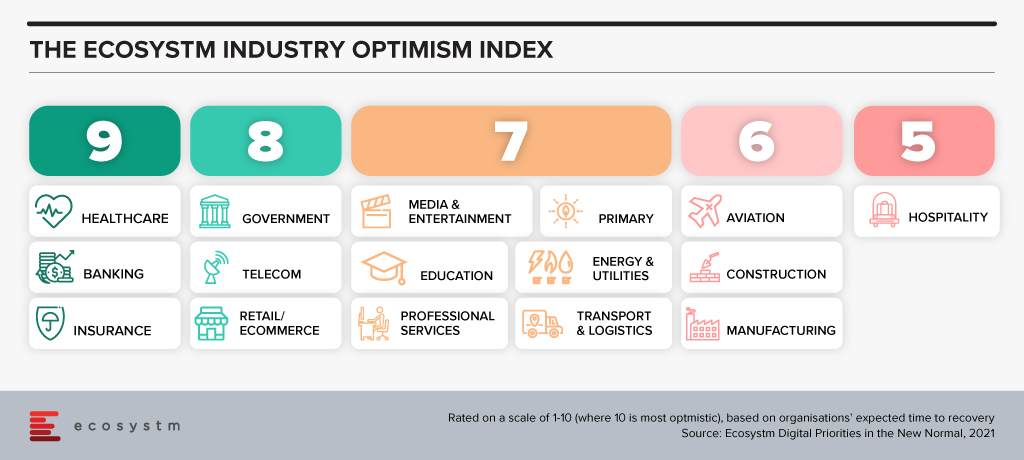
But these are not the only industries that are transforming. There are industries that have been impacted more than others. There are several instances of how organisations in these industries are demonstrating not only resilience but innovation. The Travel & Hospitality industry has had several such instances. As business models evolve the industry will see significant changes in digital channels to market, booking engines, corporate service offerings and others, as the overall Digital Strategy is overhauled.
Technologies are Evolving. Organisations depended on their tech partners to help them make the fast pivot required to survive and succeed in the last year – and tech companies have not disappointed. They have evolved their capabilities and continue to offer innovative solutions that can solve many of the ongoing business challenges that organisations face in their innovation journey. More and more technologies such as AI, machine learning, robotics, and digital twins are getting enmeshed together to offer better options for business growth, process efficiency and customer engagement. And the 5G rollouts will only accelerate that. The initial benefits being realized from early adoption of 5G has been for consumers. But there is a much bigger impact that is waiting to be realised as 5G empowers governments and businesses to make critical decisions at the edge.
Tech Start-ups are Flourishing. There are immense opportunities for technology start-ups to grow their market presence through innovative products and services. To succeed these companies need to have a strong investment roadmap; maintain a strong focus on customer engagement; and offer technology solutions that can fulfil the global needs of their customers. Technologies that promote efficiency and eliminate mundane tasks for humans are the need of the hour. However, as the reliance on technology-led transformation increases, tech vendors are becoming acutely aware that they cannot be best-in-class across the different technologies that an organisation will require to transform. Here is where having a robust partner ecosystem helps. Partnerships are bringing innovation to scale in Asia.
We can expect Asia to emerge as a powerhouse as businesses continue to innovate, embed technology in their product and service offerings – and as tech start-ups continue to support their innovation journeys.
Ecosystm CEO Amit Gupta gets face to face with Garrett Ilg, President Asia Pacific & Japan, Oracle to discuss the rise of the Asia Digital economies, the impact of the growing middle class on consumerism and the spirit of innovation across the region.

We are heading into the one-year anniversary of global COVID confinements. This confinement period has seen the Hospitality industry impacted strongly by the lack of mobility of populations and government regulations. Hotels had previously used a consistent flow of booking and revenue information using historical and current pricing data from distribution and revenue management tools. They adapted in the “new normal” and the evolution of hotel infrastructure during this period – forced by necessity – has led them to try to create a contactless, more automated interaction, both for efficiency and for the work-from-home status of many employees.
Ecosystm research shows the digital technology focus of the industry to address the necessary shifts, in 2021 (Figure 1).
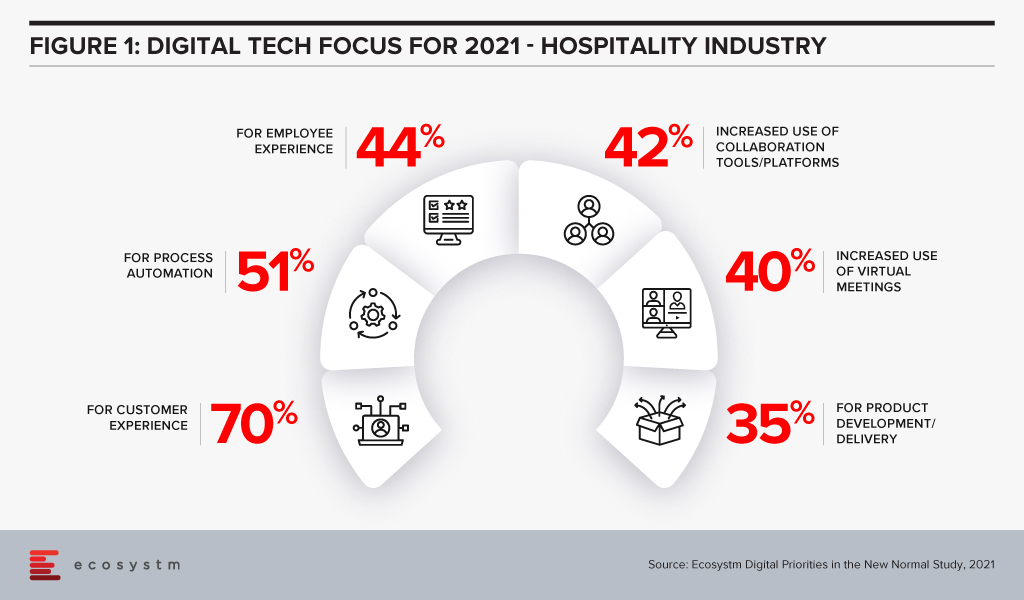
Distribution Data in the New Normal
Hotels are still struggling to get a clear overview of demand forecasting. Their data infrastructure is evolving and will continue to evolve to tackle this problem. The reliance on distribution information had to shift as fluidity in bookings could not rely on historical norms.
Hotels use a complex structure of promotion via distribution channels. This included direct booking via websites or central call centres, and use of online travel agents (OTAs), bed banks and wholesalers. That mix of channels was monitored and managed by the properties to leverage across these channels to optimise room occupancy. Over the past decades there has been an increased reliance on OTAs. But in more recent years, many hotel players have pushed back, promoting direct bookings made through own website booking engines or other direct means.
The pandemic has disrupted this complex orchestration of data. Moving from 65-75% occupancy to 10-15% was not financially viable for hotels. Because the pandemic reduced demand, both direct booking and OTA bookings have grown their share at the expense of other channels such as bed banks and global distribution systems (GDS). Guests wanted confirmation of the status of the hotel and what services were available, so data with extra content from the hotel itself or frequently updated OTA services were reliable.
Building Better Bundles and Contact Points
The goals for many hotels were to create frictionless digital customer journey (preferably by brand), leveraging existing infrastructures and integrating them to mobile apps, more robust CRM, and a more flexible property management set of tools. Part of that integration was having newly launched hygiene initiatives and branding those as part of the offering.
New bundles and packages were created to deal with the hygiene constraints and the new form of guest stays (daycation, staycation, remote learning) that have developed from the pandemic conditions.
Workcations using the hotel facilities as a workplace became attractive for those stuck at home with many interruptions. InterContinental Hotels Group, Marriott and Accor are among the major names that have launched or are considering monthly payment plans, as the hotel industry tries to attract restless remote workers ready for a change of scene.
The disconnect in guest information is being addressed by rebuilding the infrastructure of the guest journey – tracking their pre-stay investigation and booking interaction, the kind of on-property engagement they have with the hotel and its staff, their in-room experience, and their sharing of feedback on social media post-stay are all part of their guest experience.
Multiple business priorities will guide the industry in 2021 (Figure 2).
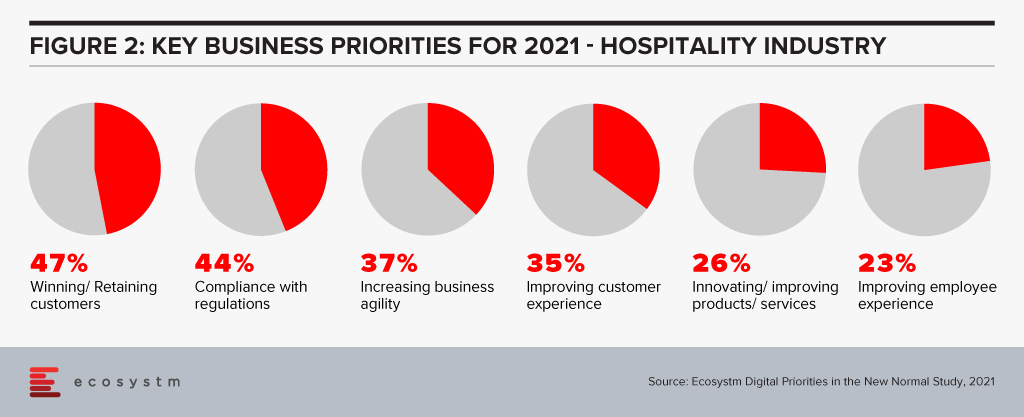
For the hotels serving different customer segments, specific actions were initiated.
- For the economy hotel chains, the flow of customers was not that significantly different, but how they booked and how many rooms they needed changed. This was handled more at the individual hotel property level as different COVID constraints applied to different regions.
- Larger chains already had their property management systems (PMS) set up as tied to a centralised structure, but a chunk of their business (leisure, corporate and business events) was directly tied to the restrictions on the domestic population and inability to access international guests.
- For luxury brands, it was a bit of a challenge as the hygiene aspect impacted the use of several extras that luxury brands rely on, such as spas, one-to-one interaction and facilities.
- Independent hotels needed some guidance that they were not getting from historical norms. Many went to external infrastructure providers to try to create workflow processes that would help them stay afloat.
Technology investments: Some Examples
One of the first concerns of regional travellers was the operational status of the hotel. One example of a digital investment was the Louvre Hotels Group, Europe’s second-largest hotel group that used used its ‘Résa Pro’ dedicated reservation platform for working professionals. It showed the listing of available accommodation per city and region for business travellers to meet the accommodation and catering needs of retail and sales professionals. Using this digital platform, companies could locate the Group’s open hotels in the city or region of their choice and see what guest offering best suited their requirements.
This webcast of Radisson’s Remy Merckx and Managing Director Sally Richards from RaspberrySky is a great example of building a digital platform to restructure the guest experience. Radisson outsourced the building of a digital platform that linked their eight hotel brands under one platform for a consistent digital experience, leveraging mobile, social and cloud technologies. The higher engagement rate with the mobile app and the chatbot helped create the contactless experience the guests are now looking in their accommodation journeys.
Many brands are now focusing on app-centric approaches for the guests, adding the value of human engagement for the more complex tasks. The emphasis is on the brand and digitising the guest journey to make it more customer-centric. This has been a time of reflection for some of the more organised hotel chains to make the time investment into the digital journey, upskill and upscale their operations to be in line with customer engagement.
New Normal for Hotel Stays
But not every independent hotel or small hotel chain had that financial investment to make during this period. According to Ecosystm data, approximately 41% of hospitality firms put their digital transformation on hold in 2020 – higher than any other industry that we cover. Technologies that will see increased investments in 2021 included cloud collaboration (44%) and cloud enterprise solutions (23%).
What does cloud have to do with this? Cloud is part of the infrastructural investment that allows the Hospitality industry to connect and enable its participants throughout the ecosystem, enabling mobile and social as well. This enables service providers to engage with intermediary partners, travel agents and consolidators and consumers, hyperconnecting in ways that provide convenience, ease of use and seamless information retrieval to bed banks and timetables, from business rules to collaborative mapping of codes.
This use of technology transforms the elements of inventory and availability into experiences and destinations.
- Messaging tools help harmonise communication across the network.
- Monitoring apps manage factors that impact distribution health, including rate integrity, availability, and visibility.
- AI – for example in the form of voice assistants – helps guide consumers and partners to timely information and decision making.
But it will still be a blend of digital solutions and human interaction, where humans add the core competency and collective knowledge, and technology provides the seamless data exchange and network connectivity.
Acknowledgements
- Sally Richards at RaspberrySky
- Anders Johansson at Hospitality Visions
- Mark Haywood and Ankit Chaturvedi at RateGain
New Normal for The Hospitality Industry
Get more insights on the priorities and the road to recovery of the Hospitality industry. Create your free Ecosystm account to take part in this study and gain access to a benchmark of how you compare to your peers.

Authored by Alea Fairchild and Audrey William
There is a lot of hope on AI and automation to create intellectual wealth, efficiency, and support for some level of process stability. After all, can’t we just ask Siri or Alexa and get answers so we can make a decision and carry on?
Automation has been touted as the wonder formula for workplace process optimisation. In reality it’s not the quick fix that many business leaders desire. But we keep raising the bar on expectations from automation. Investments in voice technologies, intelligent assistants, augmented reality and touchscreens are changing customer experience (Figure 1). Chatbots are ubiquitous, and everything has the potential to be personalised. But will they solve our problems?
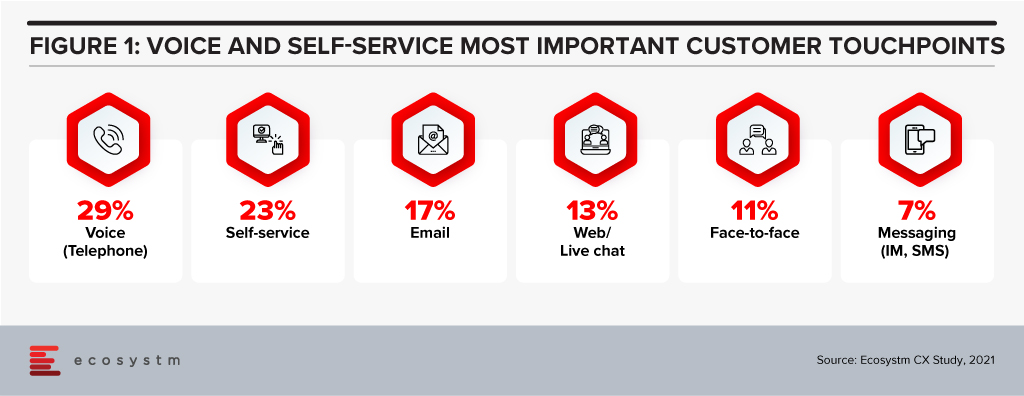
100 percent automation is not effective
Let’s first consider using automation to replace face-to-face interactions. There was a time when people were raving about the check-in experience at some of the hotels in Japan where robots and automated systems would take care of the check-in, in-stay and check-out processes. Sounds simple and good? Till 2019, if you checked into the Henn-na Hotel in Japan, you would be served and taken care of by 243 robots. It was viewed by many as a template for what a fully automated hotel could look like in the future.
The hotel had an in-room voice assistant called Churi. It could cope with basic commands, such as turning the lights on and off, but it was found to be deficient when guests started asking questions about places to visit or other more sophisticated queries. It was not surprising that the hotel decided to retire their robots. In the end it created more work for the hotel staff on-site.
People love the personal touch when they are in a hotel; and talking to someone at the front desk, requesting assistance from hotel staff, or even just a short chat over breakfast are some of the small nuances of why the emotional connection matters. Many quarantine hotels today use robots for food delivery, but the hotel staff is still widely available for questions. That automation is good, but you need the human intervention. So, getting the balance right is key.
Empathy plays a big role in delivering great Customer Experience
Similarly, there was a time when many industry observers and technology providers said that a contact centre will be fully automated, reducing the number of agents. While technologies such as Conversational AI have come along where you can now automate common or repetitive questions and with higher accuracy levels, the human agent still plays a critical role in answering the more complex queries. When the customer has a complicated question or request, then they will WANT to speak to an agent.
When it reaches a point where the conversation with the chatbot starts getting complicated and the customers need more help there should be the option – within the app, website or any other channel – to escalate the call seamlessly to a human agent. Sometimes, a chat is where the good experience happens – the emotional side of the conversation, the laughter, the detailed explanation. This human touch cannot be replaced by machines. Disgruntled customers are happier when an agent shows empathy. Front line staff and human agents act as the face of a company’s brand. Complete automation will not allow the individual to understand the culture of the company. These can be attained through conversations.
Humans as supervisors for AI – The New Workplace
Empathy, intuitiveness, and creativity are all human elements in the intelligence equation. Workers in the future will need to make their niche in a fluid and unpredictable environment; and translating data into action in a non-replicable way is one of the values of human input. The essence of engineering is the capacity to design around human limitations. This requires an understanding of how humans behave and what they want. We call that empathy. It is the difference between the engineer who designs a product, and the engineer who delivers a solution. We don’t teach our computer scientists and engineering students a formula for empathy. But we do try to teach them respect for both the people and the process.
For efficiency, we turn to automation of processes, such as RPA. This is designed to try to eradicate human error and assist us in doing our job better, faster and at a lower cost by automating routine processes. If we design it right, humans take the role of monitoring or supervisory controlling, rather than active participation.
At present, AI is not seen as a replacement for our ingenuity and knowledge, but as a support tool. The value in AI is in understanding and translating human preferences. Humans-in-the-loop AI system building puts humans in the decision loop. They also shift pressure away from building “perfect” algorithms. Having humans involved in the ethical norms of the decision allows the backstop of overly orchestrated algorithms.
That being said, the astute use of AI can deepen insights into what truly makes us human and can humanise experiences by setting a better tone and a more trusted engagement. Using things like sentiment analysis can de-escalate customer service encounters to regain customer loyalty.
The next transformational activity for renovating work is to advance interactions with customers by interpreting what they are asking for and humanising the experience of acquiring it which may include actually dealing with a human contact centre agent – decisions that are supported at the edge by automation, but at the core by a human being.
Implications
Ecosystm research shows that process automation will be a key priority for technology investments in 2021 (Figure 2).
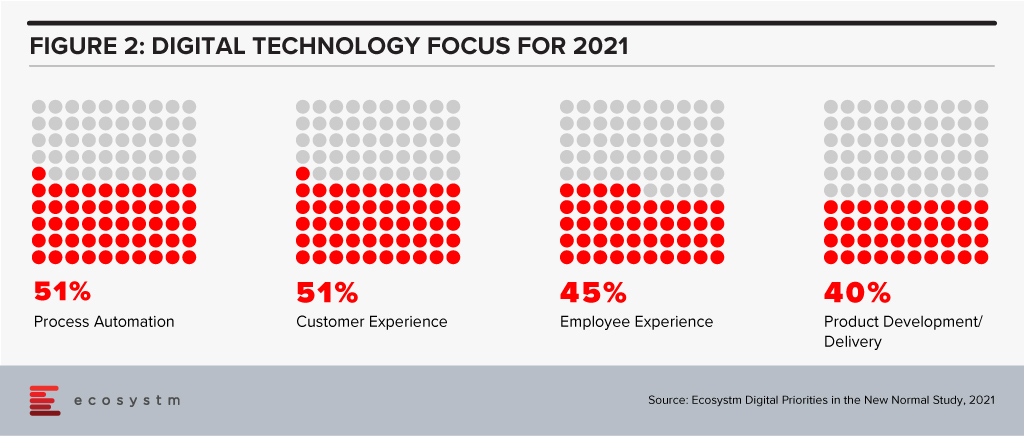
With AI and automation, a priority in 2021, it will be important to keep these considerations in mind:
- Making empathy and the human connection the core of customer experiences will bring success.
- Rigorous, outcome-based testing will be required when process automation solutions are being evaluated. In areas where there are unsatisfactory results, human interactions cannot – and should not – be replaced.
- It may be easy to achieve 90% automation for dealing with common, repetitive questions and processes. But there should always be room for human intervention in the event of an issue – and it should be immediate and not 24 hours later!
- Employees can drive greater value by working alongside the chatbot, robot or machine.
Ecosystm Predicts: The Top 5 Customer Experience Trends for 2021
Download Ecosystm’s complimentary report detailing the top 5 customer experience trends for 2021 that your company should pay attention to along with tips on how to stay ahead of the curve.

A decade ago, the axiom of a successful business model was to identify a need, find the market and then develop an idea or product that fits into that chain. It was a process of inserting a product in the customer’s already existing experience journey with the hope that the product/idea would deliver efficiency to the client. This efficiency could be financial, operational, marketing or cost savings – the uni-product, uni-feature approach.
There has been enough said about the many companies that failed to innovate beyond their existing product/feature and failed to stay ahead of the game. Nokia and Blackberry remain at the centre of any discussion about “lack of innovation”. There are others like Kodak, Canon, Napster, Palm, Blockbuster – that were devoured by innovative competitors.
The predators were ones with the vision to see the entire value chain and not just their own product. Netflix created content and distributed it, Apple touched the lives of their customers in multiple ways and AirBnb provided accommodation inventory, choice and booking all in one. The new secret sauce is to provide the customer with an ecosystem and not a product!
The Need to Transform
Cut to the COVID era – there are many businesses facing the downturn and experiencing the “moments of truth” giving rise to a desperate attempt to innovate, transform, survive, and come out as the rising stars. Ecosystm research finds that 98% of organisations have re-evaluated their Transformation roadmap (Figure 1), while 75% have started, accelerated or refocused their DX initiatives.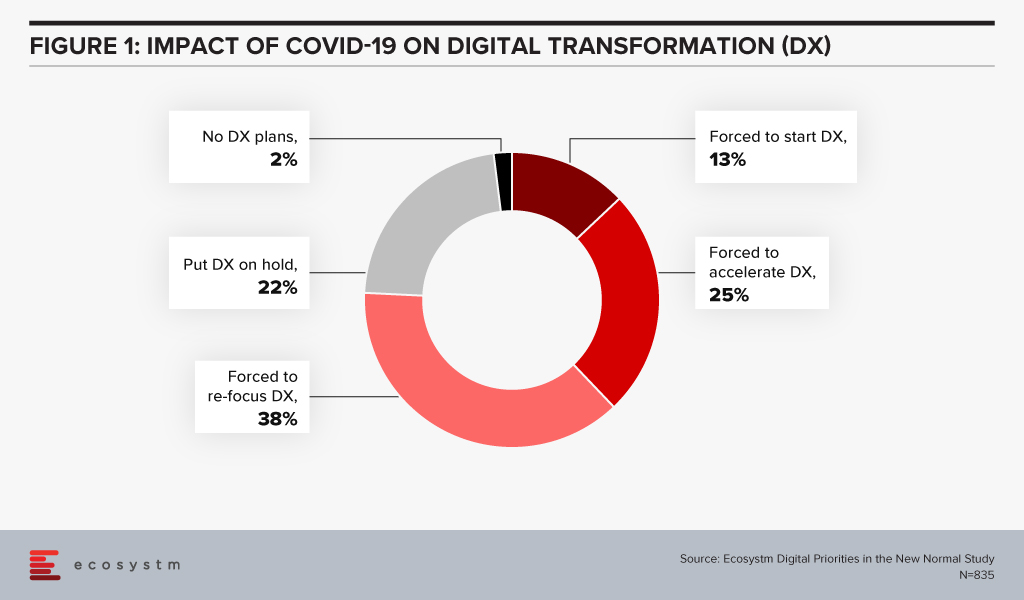
New business models are evolving, and accelerating digitalisation is the result. The digital movement, be it in food delivery or payments, is here to stay. This digital acceptance and absorption exaggerate the need for business models that capture holistic ecosystems and entire customer journeys, due to reasons that separate the hunter and the hunted.
- Margins will never be the same again as in the uni-product model. Using the F&B analogy; with the increasing number of customers wanting to dine in the comfort of their homes, restaurants cannot use ambiance as the price differentiator. Since most restaurants are available on food delivery services, customers are getting brand agnostic. This is the start of commoditisation of dining. Restaurants (or food caterers now!) will need to play the price card to remain competitive resulting in compressed margins. The food delivery market is expected to grow 4-fold to USD 8 billion by 2025 but with lower margins. This example of the food delivery model will be the same as experienced by retail, apparel and other industries.
- Customer experience will still be the differentiator and lever for loyalty and repeat purchase. Factors like proximity, parking, in-store experience, and store layout are fast getting replaced by the ease of navigation, user experience, seamless check out and finally efficient and timely delivery. The ease of transaction including multiple steps of search, assessment, evaluation, payment and delivery is of paramount importance. Customers do not want fractured journeys with multiple drop-offs. A unified seamless journey will win.
- Virtual, Digital and Automation are the three mantras that management consultants are betting on. However, this trilogy will not guarantee survival since the road to recovery is not a straight one. Different work schedules, observing various curves and on what point of the curve the business, its customer and the market are at, will add to the complexity of decision making and transformation.
Given the above, an obvious strategy to beat the existential crisis is to transform and seek out sustainable operating models. However, it may not be so simple since most businesses may not be able to change models as quickly as needed. There is an inherent cost to change since the existing processes and procedures have been well oiled and smoothed over time. The much-needed change requires the infusion of the 3Ts (time, technology, training) and associated costs. Most often, there is an inverse correlation noticed between the sturdiness of the business and its ability to be flexible to change. Businesses that are “rock-solid” and profitably sturdy and stable, have high inertia of transformation versus FinTech businesses, as an example, that pride themselves with nimble operations but are financially fragile and may not be able to absorb the cost of speedy transformation.
This Sturdy-Flexible continuum is the tight rope walk that businesses will need to walk in this need for transformation. Businesses that embark on this walk alone will find it extremely painful and lonely. Especially in the case of small business owners who are scared and low on all 3Ts.
The Rise of Ecosystems
The new world has manifested that businesses that use physical space or assets as their competitive advantage are more prone to be impacted. Retail, Education, Hospitality and Entertainment are some obvious examples that have been impacted by the physicality in their propositions. Digital businesses are more agile but have suffered in their inability to scale up in time to capture the increased demand.
Fashion retailer FJ Benjamin has decided to shut 300 physical stores and rely on online sales. This strategy also helps to utilise precious time to scale diversification. Other retailers too have been going down the FJ Benjamin path and ramping up eCommerce as this trend is expected to stick beyond COVID-19.
Zouk, the renowned nightclub with 30,000 square feet of space in Singapore uses this venue as a live streaming venue during the day to host bazaars for eCommerce vendors. From June 2020, it launched an online shop selling merchandise, bottled cocktails and food from its RedTail kitchen.
Transformation of businesses will require capabilities that were not created within their models. The instinct to survive in the short term will require businesses to create symbiotic partnerships. This will require some fresh thinking by business leaders.
- Change the “Build” obsession and not try to own every leg of the customer journey. That will not only take time but also distract capital and management.
- Rethink the customer needs – and this time think of the entire journey rather than an inward view of product-market fits. Customer needs are changing at breakneck speeds, so chasing and “building” these “fits” will always remain a common string amongst laggards.
- Connect with like-minded ecosystem players and complement strengths with a single-minded focus on solving customer problems.
- View technology stacks through the lens of your partners. There may be opportunities available from near open source technology solutions.
For example, FJ Benjamin will need the last-mile-delivery capability that will be provided by partners who have optimised in that field, Zouk has tied up with Lazada to host the bazaars and GrabFood is using underutilised taxi capacity to meet the increased demand for food delivery. There are many other examples in the O2O (Offline to Online) space.
This ecosystem approach is also relevant to other sectors like Financial Services. These firms also need to understand the changing consumer needs faster, with a mantra to deliver. Aspire, originally an alternate lending platform has gone through a metamorphosis and transformed into a Neobank. From a uni-product loan provider, it is now solving for a business account, card solution, integration with expense management solutions and continue to provide loans. Capabilities not necessarily built in-house.
The changing world will give rise to business models that will integrate and complement each other. Businesses with an ecosystem mindset will be winners while others might just be relegated to oblivion.



